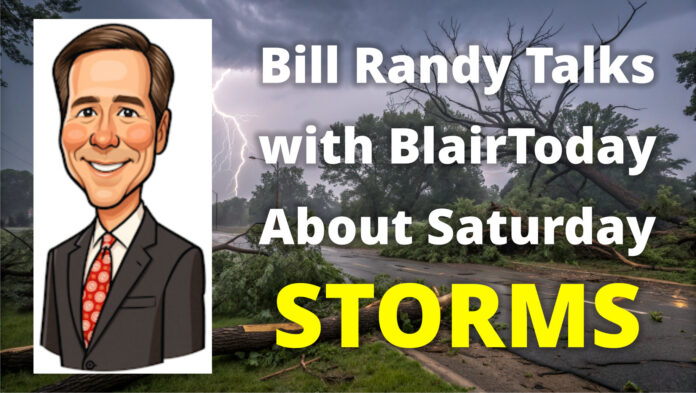BLAIR, NEBRASKA (2025 August 13, Wednesday)
Don Harrold, Writer / Editor
editor@blairtoday.com – Facebook
Saturday morning’s devastating windstorm left Blair residents picking up the pieces once again, with multiple people seriously injured at River View Park Resort & Marina, the Dollar General building sporting massive holes, and a state of emergency declared through Monday.
The repeated severe weather hits have led many in the community to wonder: Is Blair cursed with bad weather geography, or just experiencing a string of bad luck?
BlairToday consulted weather experts and utility officials to answer three key questions about Saturday’s storm and Blair’s apparent vulnerability to severe weather.
Defining Saturday’s Storm
The storm that woke residents with emergency alerts and 80+ mph winds defied easy classification, according to meteorologists.

Bill Randby, Chief Meteorologist at KETV-TV, told BlairToday, Saturday’s event as “a thunderstorm downburst that lasted for several hours, but not long enough to be called a Derecho.” The storm created “a nasty swath of damage from south central Nebraska, through Lincoln (91mph gust) up to far western Douglas county and into Blair with some similar gusts.”
Professor Adam Houston from the University of Nebraska-Lincoln took a more cautious approach to classification. “It doesn’t seem to fit cleanly into a storm classification. I’d call it a mesoscale convective system but, honestly, that’s a pretty generic term, though it captures its size and that there was internal organization.”
What both experts agreed on was the storm’s extraordinary power. Meteorological data showed atmospheric energy levels of 4000 j/kg—nearly three times the 1500 threshold considered sufficient for severe storms. At its peak, the system generated nearly 2000 lightning strikes every 10 minutes.
Timing Matters
Many residents wondered whether the storm would have been more destructive if it had struck during peak heating hours on a hot Friday evening instead of early Saturday morning.
Both experts suggested Saturday morning timing may have actually been near-optimal for storm intensity.
“Perhaps it could have been worse with a Friday evening timing, but the low level wind (Low Level Jet) was at a peak 3:00am-6:00am Saturday morning, so not necessarily would it have been stronger with a different timing,” Randby said.

Houston explained that storm development requires time to build the internal organization essential for severity. “Given the climatology of thunderstorm initiation (in our part of the country it peaks around the 4-6 pm time frame) and the time required for internal organization, I’d say that, practically, the storm wouldn’t have been worse” with Friday evening timing.
He added that Saturday’s storm already had exceptional atmospheric energy available. “The atmospheric instability in place for this storm was anomalously large so, even though it happened late at night, the extra ‘juice’ available at peak heating wouldn’t have made a lot of difference.”
The ‘Storm Magnet’ Question
The perception that Blair consistently attracts severe weather found pushback from meteorological experts, though utility officials acknowledged infrastructure factors that may increase the community’s vulnerability.
Randby, drawing on decades of regional storm tracking, offered historical perspective: “I know to someone living in Blair it seems like you are always getting the worst storm, but I argue that is not always the case.”
He cited major storms that devastated other areas: the 2020 Midwest Derecho that produced 126 mph winds near Cedar Rapids, Iowa; the July 31, 2024 storm that left 230,000 OPPD customers without power; and the June 27, 2008 downburst that hit central Omaha with 115 mph winds, affecting 170,000 customers.
“You certainly have been hard hit the last couple of years in Blair! The tornadoes and high wind events were rough last summer,” Randby acknowledged, but noted that severe storms have historically impacted communities throughout the region.
Houston’s scientific analysis reached similar conclusions about Blair’s geography. “I don’t think so, but I’d need to look more closely into this,” he said regarding whether Blair faces inherent weather vulnerability.
He explained that “the upstream geography (near where the storms initiate [well west of here usually]) is probably more important overall because it sets into motion the storm evolution that is seen downstream.” Local terrain effects exist but are “probably modest at best and felt on a house-by-house basis, not over a whole city or region.”
Utility Perspective Reveals Infrastructure Factors
Shannon Ankeny, Manager of External Communications for Omaha Public Power District, provided insight into why some areas may experience more severe storm impacts, though she stopped short of calling any location a consistent problem area.
“Every storm is different,” Ankeny said, noting that “different areas of the OPPD service territory have different needs and designs due to considerations like topography, vegetation, population density and age of the infrastructure.”
Crucially, she explained that “more rural areas tend to have more exposed infrastructure that are more susceptible to high winds and thereby outages caused by downed or broken poles, while more urban or densely populated areas tend to experience outages due to downed trees on above-ground lines.”
This suggests Blair, as a more rural community, faces inherent infrastructure vulnerability to high-wind events.
For Saturday’s response, OPPD deployed significant resources, with “nearly 500 field workers deployed across the hardest-hit areas, which included Blair, Ashland, Fort Calhoun, Bennington and rural Washington and Saunders counties,” Ankeny said. Crews restored 72% of outages within 48 hours.
Notably, Ankeny specifically identified Blair among the “hardest-hit areas,” lending credibility to residents’ perceptions.
OPPD has been actively improving storm preparedness, Ankeny said. “Every time we experience a major outage due to extreme weather conditions, we make notes of the lessons learned, implement improvements in our plants and processes, and thereby ensure we are more prepared for the next storm.”
The utility’s improvements include “undergrounding power lines as it is financially and practically feasible – about 20 to 40 miles of line every year, increasing vegetation management like tree-trimming, and replacing existing, aging infrastructure as well as investing in new generation assets, such as Turtle Creek Station and Standing Bear Lake Station.”
Blair residents can expect specific infrastructure improvements in coming years, including “cable and conductor replacements, substation expansions and improvements, and other improvements on the distribution system,” Ankeny said.
Looking Forward
The expert analysis suggests Blair’s recent severe weather streak reflects unfortunate timing rather than geographic doom, though infrastructure factors may amplify storm impacts in rural communities like Blair.
OPPD’s acknowledgment that Blair was among Saturday’s “hardest-hit areas,” combined with explanations about rural infrastructure vulnerability, indicates some factors beyond pure chance may be at work.
The utility’s commitment to specific infrastructure improvements in Blair, along with ongoing system-hardening efforts including advanced technology like thermal cameras and drone monitoring, may help reduce future storm impacts.
As the community continues recovery efforts, residents can take some comfort that Saturday’s storm was an exceptional event—and that concrete steps are being taken to better prepare for whatever weather may come next.




Great article. If the storm was more severe than usual but not a derecho and not a downburst, maybe it should get a name.. I suggest a Blair-burst.
I agree with the timing not a factor. The Iowa derecho in 2020 started in the morning. Also, later in the summer it seems storms happen later at night and early morning more often than afternoons, like they do in spring and early summer.
As far as geography, I wonder if the meteorologists would acknowledge the “Oma-dome” but still deny any increased storm activity north or south of Omaha at the edges of the “dome”. It seems like if there is an atmospheric or geographic feature deflecting storms around Omaha on occasion, that those storms would intensify as they compress moving around the “dome”.
I’ve lived in Blair for a couple decades, and agree that storm was unusual from the combination of intense strobe lightning with constant thunder, high winds, and 6-7 inches of rain in an hour. The constant rumbling noise from the thunder, wind, and rain lasted for over 30-45 minutes. The only storms I’ve seen do that are hurricanes. Thankfully it didn’t meet that criteria or last as long as a hurricane, but the duration seemed a lot longer than a typical severe thunderstorm.
Thanks for the thoughtful comment! “Blair-burst” is actually a pretty clever term – it does seem like Saturday’s storm deserves its own classification given how it defied the usual categories.
Your observation about the “Oma-dome” is fascinating and something I’d love to explore further with meteorologists. The idea that storms might intensify as they compress around atmospheric features that deflect weather around Omaha is intriguing – it could explain why areas like Blair seem to get hit harder when storms do come through.
You’re absolutely right about the unusual characteristics of Saturday’s storm. That constant rumbling and the hurricane-like duration you described came up in several conversations I had with residents. The combination of that strobe-light lightning show, sustained winds, and the incredible rainfall amounts (some areas got 4+ inches in under an hour according to the meteorological data) really did create something exceptional.
Your point about seasonal timing patterns is spot-on too. Bill Randby mentioned how the Low Level Jet was peaking in those early morning hours, which helps explain the storm’s intensity at that time.
I’m curious – in your couple decades in Blair, have you noticed any patterns in where the most severe storms tend to track through town? Some residents have mentioned certain areas seem to get hit harder than others. The “compression” theory you mentioned might explain some of those micro-patterns too.
Thanks for reading and for the insightful feedback!